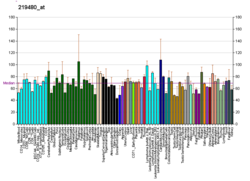| SNAI1 |
|---|
 |
|
| Structures disponibles |
|---|
| PDB | Recherche d'orthologue: PDBe RCSB |
|---|
| Identifiants PDB |
|---|
2Y48, 3W5K, 4QLI |
|
|
| Identifiants |
|---|
| Aliases | SNAI1 |
|---|
| IDs externes | OMIM: 604238 MGI: 98330 HomoloGene: 4363 GeneCards: SNAI1 |
|---|
| Position du gène (Homme) |
|---|
 | | Chr. | Chromosome 20 humain[1] |
|---|
| | Locus | 20q13.13 | Début | 49,982,980 bp[1] |
|---|
| Fin | 49,988,886 bp[1] |
|---|
|
| Position du gène (Souris) |
|---|
 | | Chr. | Chromosome 2 (souris)[2] |
|---|
| | Locus | 2 H3|2 87.33 cM | Début | 167,380,115 bp[2] |
|---|
| Fin | 167,384,734 bp[2] |
|---|
|
| Expression génétique |
|---|
| Bgee | | Humain | Souris (orthologue) |
|---|
| Fortement exprimé dans | - vésicule biliaire
- left uterine tube
- right lobe of thyroid gland
- left lobe of thyroid gland
- aorte ascendante
- upper lobe of left lung
- poumon droit
- artère coronaire gauche
- artère coronaire droite
- right adrenal gland
|
| | Fortement exprimé dans | - Crête neurale
- mésoderme
- calvaria
- placenta
- Sclérotome
- morula
- maxillary prominence
- allantoïde
- tracheobronchial tree
- derme
|
| | Plus de données d'expression de référence |
|
|---|
| BioGPS |  | | Plus de données d'expression de référence |
|
|---|
|
| Gene Ontology |
|---|
| Fonction moléculaire | - sequence-specific DNA binding
- liaison ADN
- RNA polymerase II transcription regulatory region sequence-specific DNA binding
- liaison ion métal
- liaison de kinase
- liaison protéique
- DNA-binding transcription repressor activity, RNA polymerase II-specific
- Fixation d'acide nucléique
- DNA-binding transcription factor activity, RNA polymerase II-specific
- E-box binding
| | Composant cellulaire | - noyau
- cytoplasme
- nucléoplasme
- pericentric heterochromatin
- cytosol
| | Processus biologique | - trophoblast giant cell differentiation
- roof of mouth development
- regulation of bicellular tight junction assembly
- positive regulation of cell migration
- regulation of transcription by RNA polymerase II
- epithelial to mesenchymal transition involved in endocardial cushion formation
- negative regulation of intrinsic apoptotic signaling pathway in response to DNA damage
- développent d'un organisme multicellulaire
- negative regulation of vitamin D biosynthetic process
- régulation positive de la transcription dépendante de l'ADN
- negative regulation of DNA damage response, signal transduction by p53 class mediator
- osteoblast differentiation
- negative regulation of cell differentiation involved in embryonic placenta development
- cartilage morphogenesis
- hair follicle morphogenesis
- left/right pattern formation
- mesoderm development
- negative regulation of transcription, DNA-templated
- migration cellulaire
- negative regulation of transcription by RNA polymerase II
- Notch signaling involved in heart development
- mesoderm formation
- Transition épithélio-mésenchymateuse
- positive regulation of epithelial to mesenchymal transition
- heterochromatin organization
- aortic valve morphogenesis
| | Sources:Amigo / QuickGO |
|
| Orthologues |
|---|
| Espèces | Homme | Souris |
|---|
| Entrez | | |
|---|
| Ensembl | | |
|---|
| UniProt | | |
|---|
| RefSeq (mRNA) | | |
|---|
| RefSeq (protéine) | | |
|---|
| Localisation (UCSC) | Chr 20: 49.98 – 49.99 Mb | Chr 2: 167.38 – 167.38 Mb |
|---|
| Publication PubMed | [3] | [4] |
|---|
|
| Wikidata |
| Voir/Editer Humain | Voir/Editer Souris |
|

 Portail de la médecine
Portail de la médecine  Portail de la biologie cellulaire et moléculaire
Portail de la biologie cellulaire et moléculaire 


















